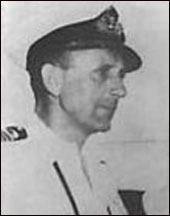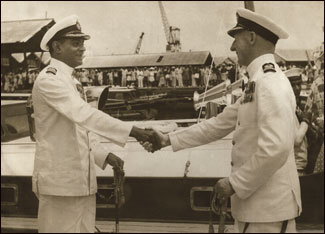|
Sri Lanka Navy:
Diamond Jubilee celebrations
Special correspondent
Committed to protect the sovereignty and territorial integrity of the
Motherland, preserving the strength it gained by its pivotal
contribution to the eradication of the 30-year long brutal terrorism off
the Lankan soils intact, utilizing the same efforts used for the
destruction of the supply and escape routes of the terrorists through
its continuous surveillance along our coastal belt and territorial
waters and thwarting the re-emergence of terrorism in the country, Sri
Lanka Navy is fortifying itself into a more formidable force today.
|

Captain W E Banks,
CBE (Royal Navy) |
The necessity to re-establish a Naval Force was felt during World War
I in the island of Sri Lanka, which had once made admirable victories in
Naval battles having sailed into foreign countries during the reigns of
its great kings such as Parakramabhahu and Vijayabhahu.
Sri Lanka Navy came into being 60 years ago on December 9, 1950 as
the Royal Ceylon Navy with the integration of the Royal Ceylon Volunteer
Navy and the Ceylon Royal Naval Volunteer Reserve (CRNVR) which expanded
from the Ceylon Naval Volunteer Force (CNVF) formed as a fulfillment of
that necessity.
During the period Captain Banks became the Commander of the Navy. In
the 1950s, Royal Ceylon Navy received the ship ‘Vijaya’ from Britain as
a gift. The commissioning ceremony of this ship was presided over by the
late Prime Minister D S Senanayake.
Queen Elizabeth
It was onboard the ship ‘Nonik’ that Queen Elizabeth arrived in
Ceylon in 1954 as the Head of the Commonwealth. It was the Royal Ceylon
Navy which accorded the Guard of Honour to her. In 1954 Drum Major Cruse
made a creative contribution by training a music band for the Royal
Ceylon Navy.
0n September 19, 1955, the helm of the Navy was transferred from
white hands to black hands with the handing over of the post of
Commander of the Royal Ceylon Navy to Captain Royce de Mel by the last
European Captain Chavasse.
During this decade the challenging task entrusted to the Royal Ceylon
Navy was the tackling of illegal immigrants and smugglers arriving from
South India. The Karainagar Naval Base was established to prevent this
menace. The small vessels ‘Hansaya’ and ‘Lihiniya’ were acquired as a
solution to this preventive policy.
Royal Ceylon Navy
It was in the year 1957 after the acquisition of the Trincomalee
Military Base by the late Prime Minister S W R D Bandaranaike from
Britain that the Royal Ceylon Navy entered the era of expansion.
|

Royce de Mel of the Ceylon Navy bids good-bye to Commodore P B M
Chavasse, the last European Captain of the Ceylon Navy, on the
eve of his departure to England. File photo |
The entrusting of the security of the Colombo Harbour to the Royal
Ceylon Navy with the outbreak of the general strike in 1958 marked its
entry into fulfill a complex range of duties.
In the 1960s, ‘Vijaya’ as well as ‘Mahasen’, ‘Parakrama’ and ‘Gajaba’
made appearances in the Sri Lankan maritime stage only to render
seamanship training and to perform ceremonial duties.
It was impossible to prevent the increasing smuggling and illegal
Indian immigrant activities in the North with the big vessels with large
displacements. Therefore, the Navy badly felt the need for fast vessels
with reduced displacements. The Navy acquired Asia’s fastest vessel
‘Hydrofoil’ as a result.
Protecting ocean
In the 1960s, the Navy had to pay more attention to the security and
the protection of the country than to its entrusted duties. The
responsibility entrusted to protect the people and the public property
was greater than that of protecting the ocean. The Navy, which had faith
in peoples’ peaceful co-existence for the maintenance of public law and
order, went about on the public roads as exemplary sailors exhibiting a
very high degree of discipline.
In the 1970s with the entry of Diesel-powered vessels into the
maritime scene, the steam-powered ‘Vijaya’, ‘Parakrama’, ‘Mahasen’ and
‘Gajabah’ had to make a sad exit. The need badly felt was not to
restrict the Navy’s future existence to a few small vessels. With
friendly relations developed with socialist countries after Sri Lanka
becoming a republic on May 22, 1972, Russia and China came forward to
provide new ships. As a result, the Navy acquired the Russian ship ‘Samudradevi’.
However, the Navy decided to acquire more Chinese ships since they
suited Sri Lankan waters better. With the acquisition of Chinese ships,
the maritime avenues were widened to pursue more powerful targets than
before. However, the head start given by the British Navy can never be
forgotten.
Until the mid 1980s, Sri Lanka Navy was involved in traditional Naval
duties such as protection of territorial waters, prevention of illegal
immigration and smuggling, search and rescue operations, providing
protection to fishermen, assisting civil administration and assisting
the Government during national disasters. Participation in national and
State festivals was also among the duties.
Terrorist activities
With the emergence of the LTTE Sea Tiger wing known as ‘Kadalpura’ in
1985, Sri Lanka Navy entered into the prevention of terrorist activities
at sea in addition to its traditional duties. With this, the fighting
power of the Navy gradually increased and, as an initial step, the Fast
Attack Crafts’ known as ‘Dvoras’ were acquired in the mid 1980s. These
fast attack crafts were used specially to prevent terrorist activities
in the Northern and Eastern coastal areas and to destroy Sea Tiger boats
by launching attacks in addition to the protection of territorial
waters. Meanwhile, the Navy added several surveillance vessels as well.
Sea supply routes
In response to the growing Sea Tiger activities and staying ahead of
them, the Navy developed its fighting power by rapidly increasing its
manpower, training, fighting capability and technology. Although the
terrorists had developed their suicide craft by the mid 1990s, the Navy
was able to maintain its ability to counter the terrorists’ suicide
threat.
|

Ceylon Navy gunboat. Picture taken in 1972. |
The Navy’s other vessels and ships accordingly made immense
contributions by making surveillance and patrolling of high seas to
block the sea supply routes used for smuggling arms to the terrorists
and providing support to the sea battles launched by Fast Attack Craft.
Meanwhile, the Navy assisted in the transportation of Security Forces
personnel required for ground operations, landing of troops and
providing fire power for the battles from the sea whenever needed.
It also made immense contributions to the constant provision of all
supplies to the Security Forces personnel through the Naval supply
routes centering the Trincomalee Base in the face of suicide attacks of
the terrorists and transportations of troops by Naval vessels.
The Navy acted with great commitment to transport essential supplies
to sustain the lifeblood of the innocent civilians in the North and to
attend to their transportation needs.
Economic centres
Although the terrorists desperately attempted to destroy the
strategic economic centres of Sri Lanka and our harbours by launching
attacks, the Navy, providing constant security, thwarted all attacks on
harbours and never allowed the terrorists to succeed.
The Special Boat Squadron (SBS) of the Sri Lanka Navy, launched in
the mid 1990s with the attacks launched in the Jaffna Lagoon against
terrorists by the Navy, made great contributions to the Naval operations
by fighting the enemy on land, at sea and by air bravely and destroying
formidable enemy targets successfully.
With the commencement of battles in the operational areas against the
terrorists, the need was felt to establish a Patrolman Branch to assure
the safety of the armoured vehicles transporting materials and personnel
needed for the administrative purposes in the Naval bases and to
maintain Naval dominance by launching attacks in the adjacent areas for
the protection of the Naval bases.
The new branch rapidly grew in strength by 1997. It was the Navy’s
Patrolman Branch that provided immense contributions for over three
years to the protection of the areas liberated in the ‘Jaya Sikuru’
operations, providing of security to all islands in the North from the
late 1990s and to the security of coastal belt North and South of the
Trincomalee Harbour and Mannar island as well as land areas in
Silawathura and Mullikulum areas along the North-Western coastal belt
from the beginning of the humanitarian operations.
For the Naval operations conducted at sea as well as coastal areas
and the security of the Naval Bases, the Navy’s Intelligence Branch
became fully established by the late 1980s for the gathering and
analysis of information related to terrorist activities and it made
immense contributions to the planning and the successes of the Naval
operations.
Warfare strategies
Thwarting terrorist attacks from the sea for three decade, Sri Lanka
Navy destroyed their backbone with the experience gained from constant
sea battles while developing its own maritime warfare strategies and
tactics.
When a bunch of terrorists, who made escape across the Palk Straits
in small dinghies armed with a handful of guns, transformed themselves
into a brutal terrorist group called Sea Tigers capable of attacking
Naval and merchant ships using fast attack vessels and suicide craft,
Sri Lanka Navy, accordingly developed its fighting power and faced the
threat bravely developing its own innovative counter maritime warfare
strategy with the support of the Fast Attack Craft combining
conventional and asymmetric warfare strategies.
Operating along the same strategies, the Navy took the world by
surprise with the small boat concept by combining the forces of the
Special Boat Squadron (SBS) and the Rapid Action Boat Squadron.
The world maritime powers today eagerly seek the Navy’s battle
experiences and its innovative strategies, which they have never known
before, to counter maritime terrorism.
To be continued |



